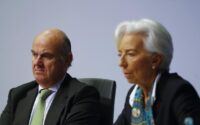Millions of US borrowers brace for the return of student debt payments
This October, after a three-year break, 27mn Americans with student debt will once again have payments due.
One of them is Jacque Abron, a Dallas public school teacher who owes $103,000 in student debt. “I’m an underpaid teacher,” said Abron, 45. “I have three kids; one is starting on her own college [degree]. I’m going to take these loans to the grave with me.”
The Department of Education paused student loan repayments when the Covid crisis began in March 2020, and extended it nine times in an effort to provide financial relief to US households throughout the pandemic.

But that is now ending, after Congress put a halt to the programme as part of an agreement resolving the debt ceiling stand-off earlier this year. Some economists fear that the resumption of payments, combined with a softening labour market and rising interest rates, could dampen consumer spending and raise balances on other consumer debts, weighing on the broader economy.
In yet another blow to student borrowers, the Supreme Court ruled Friday that US President Joe Biden’s $400bn student loan forgiveness plan, which would have cancelled up to $10,000 of debt for borrowers making up to $125,000 — and up to $20,000 for those who received a Pell Grant, a type of loan for those with the greatest financial need — was unconstitutional.
The programme would have completely eliminated the student debts of 20mn Americans, the White House said. Biden said on Friday that his administration was exploring other legal pathways to help borrowers. “I will not stop fighting to deliver relief to borrowers who need it the most,” he said.
Some 43mn Americans have students loans, though 6mn are not paying because they are still in school, 4.6mn have defaulted, 3.1mn have deferred payments, and 1mn are in a grace period before payments begin. Before the pause, the average student borrower paid between $200 and $299 each month on their loans, according to Federal Reserve data.
In a Morgan Stanley consumer survey, only 29 per cent of respondents said they would be able to make payments on their student loans without adjusting their spending.
Many borrowers have used their extra cash on things such as investing, saving for retirement, or paying down other debts. Others took it as an opportunity to splurge on experiences they knew they would not be able to afford while paying down their loans, said Zenith Wealth Partners managing partner Chelsea Ransom, a financial planner who primarily advises millennials, many of whom have student debt.
Abron, who has not received a bill or accumulated interest on her loans for the past three years, said the forbearance allowed her to save for a down payment on a home.
“People have been thinking ‘we’ll be fine, we’ll get through this’, but I think once you actually see it coming out of your pay cheque, that’s when the real reality bites and when we do see a shift coming through in terms of consumer attitudes,” said James Knightley, chief international economist at ING. “I think it will be quite a painful story unfortunately, because 43mn Americans is a big chunk of the population.”

Estimates vary on the ultimate impact, but based on calculations from the Bureau of Economic Analysis, a full resumption of related payments would be equivalent to about 0.2 percentage points of disposable income, said Aditya Bhave, senior US economist at Bank of America.
“A lot of people really enjoyed the pause and forgot how much they were paying and never thought that payments would return,” Ransom said. Her clients plan to cut back on dining out, travel, and investing in order to fit their loan payments back into their budgets.
“This is a very sobering moment,” Ransom added.
While consumer balance sheets on the whole are healthy — buoyed by a savings buffer and a robust labour market — strains have begun to emerge on the margins. More Americans are falling behind on payments for credit card debt and auto loans, and that pressure could build once the payments pause ends: “$20,000 is not going to help me,” Abron said.

“There could be knock-on effects to other components of household debt,” said Bhave. “People who struggled to pay their student loans might end up going delinquent on their credit card loans or their auto loans.” He estimated that so-called “serious” delinquency rates, which are 90 days late or more, could rise nearly 70 per cent over time as a result.
Should the labour market crack more meaningfully, especially as the Federal Reserve’s efforts to tame inflation by rapidly raising borrowing costs start to bite, vulnerable populations could be pushed further to the edge. Wendy Edelberg, director of the Hamilton Project at the Brookings Institution, said some degree of economic cooling should be welcome, with consumer spending and the labour market still “unsustainably strong”. Ending student loan relief could help that process in some capacity.
“This actually in a business-cycle management sense goes in the right direction because it is yet another force that would reduce spending,” she said, noting that the “crisis” backdrop that prompted these policies had long passed.
Some borrowers say that they still need help to repay their loans amid rising prices, and that the forbearance alone did not provide enough relief.
Abron said that her initial application for a mortgage stalled because the lender factored her roughly $500 monthly payment into calculations of her debt to income ratio despite the forbearance, although she was eventually approved. She said she has applied for a federal loan forgiveness programme for public servants, but has yet to be approved.
Joanna Kearns, 42, of Broward County, Florida, said the end of the pause was “unfair.” She echoed complaints shared by many borrowers that the education department did not properly inform them about student debt before offering them loans as teenagers.
Kearns, who works as a full-time caregiver for her elderly father as he undergoes cancer treatments, owes roughly $60,000 from two degrees.
“I’m trapped and really deserved this break,” Kearns said. “They trapped us for the rest of our lives over one mistake.”
This article has been amended since first publication to correct the name of Jacque Abron. We apologise for the initial error. The article has also been updated to reflect that Abron has received mortgage approval
[ad_2]
Source link


